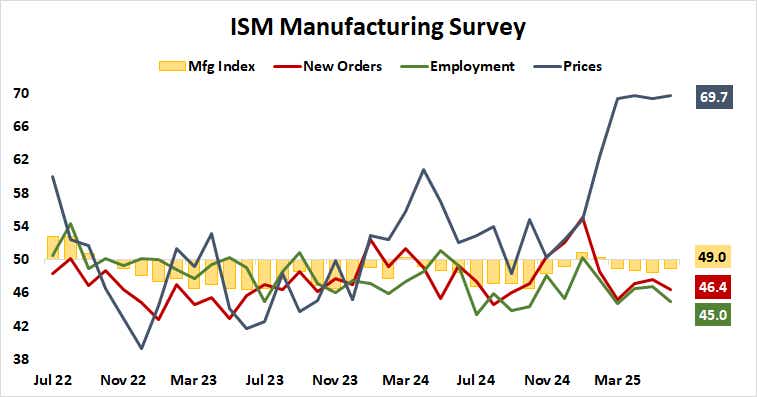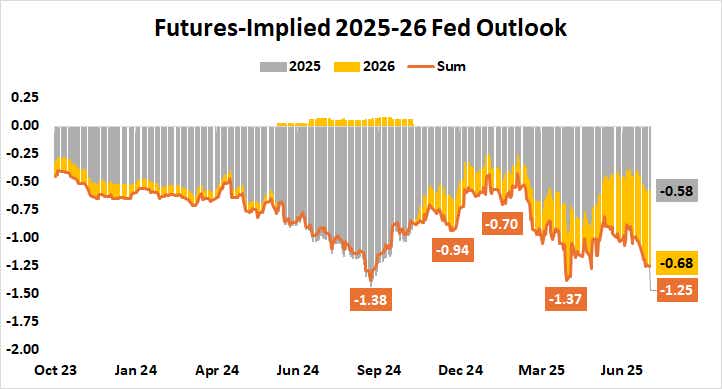Markets Fear Recession More Than Inflation. Will the Fed Finally Listen?

Markets Fear Recession More Than Inflation. Will the Fed Finally Listen?
By:Ilya Spivak
The markets still think the Fed is wrong about interest rates. Which side will prove right?
- Fed Chair Powell keeps pushing back on rate cut urgency at ECB Forum.
- ISM manufacturing survey highlights worrying “stagflation” dynamics.
- The markets are at odds with the Fed on rates and calling for more cuts.
Federal Reserve Chair Jerome Powell stuck to a familiar script in remarks made at the annual European Central Bank (ECB) forum in Sintra, Portugal. The economy is in a “pretty good position” and inflation is “behaving as expected and hoped,” but for the tariffs rushed out by the Trump administration. They are expected to boost prices over the summer.
Powell repeated that a “solid majority” of Fed officials expect to be cutting interest rates this year, but while the economy is solid, it remains prudent to wait and size up whatever tariff-related price shock is ahead. He added that he “can’t say whether July is too soon to consider a cut,” but called the current setting of policy “modestly restrictive.”
US manufacturing data flags worrying “stagflation” patterns
A survey tracking the performance of US manufacturing from the Institute of Supply Management (ISM) seemed to underscore Powell’s worries. It showed that price growth in the sector accelerated in June to almost match the three-year high clocked in April. Overall, the data said costs grew at the fastest rate since mid-2022 in the second quarter.

The ISM report also highlighted the Fed’s concerns about the tariffs regime’s negative implications for economic growth. Manufacturing activity growth shrank for the fourth consecutive month as new orders and employment in the sector continued to fall, and at a faster rate. Job losses accelerated to the quickest pace in three months.
Benchmark Fed Funds interest rate futures have priced in 58 basis points (bps) in cuts this year and 68bps in 2026. The latter is a sharp departure from what officials wrote down in the latest Summary of Economic Projections (SEP) last month, which had just 25bps of stimulus next year. Traders and the central bank are broadly aligned for 2025.
The markets still do not believe the Fed on rate cuts
The probability of a cut in July is 21.2%, having hovered near 20% for the past month. It jumps to nearly 73% in September, pointing to that policy meeting as the start of this year’s easing effort. A second cut is narrowly favored by October, and the probability of a third one before the end of the year is tellingly just a bit better than even, at 55.8%.

The bond market echoes this thinking. Prevailing inflation expectations baked into Treasury pricing – so-called “breakeven rates” – have trended pointedly lower since mid-May. That suggests the markets are more worried about a disinflationary economic downturn than a sticky price shock from the tariffs.
From here, the service-sector ISM survey and June’s official US employment data are in focus. The former is expected to bring a modicum of sluggish growth in June following a contraction in the prior month. For the latter, economists have penciled in a rise of 110,000 jobs, which would be the smallest increase in eight months.
Ilya Spivak, tastylive head of global macro, has 15 years of experience in trading strategy, and he specializes in identifying thematic moves in currencies, commodities, interest rates and equities. He hosts #Macro Money and co-hosts Overtime, Monday-Thursday. @Ilyaspivak
For live daily programming, market news and commentary, visit #tastylive or the YouTube channels tastylive (for options traders), and tastyliveTrending for stocks, futures, forex & macro.
Trade with a better broker, open a tastytrade account today. tastylive, Inc. and tastytrade, Inc. are separate but affiliated companies.
Options involve risk and are not suitable for all investors. Please read Characteristics and Risks of Standardized Options before deciding to invest in options.
tastylive content is created, produced, and provided solely by tastylive, Inc. (“tastylive”) and is for informational and educational purposes only. It is not, nor is it intended to be, trading or investment advice or a recommendation that any security, futures contract, digital asset, other product, transaction, or investment strategy is suitable for any person. Trading securities, futures products, and digital assets involve risk and may result in a loss greater than the original amount invested. tastylive, through its content, financial programming or otherwise, does not provide investment or financial advice or make investment recommendations. Investment information provided may not be appropriate for all investors and is provided without respect to individual investor financial sophistication, financial situation, investing time horizon or risk tolerance. tastylive is not in the business of transacting securities trades, nor does it direct client commodity accounts or give commodity trading advice tailored to any particular client’s situation or investment objectives. Supporting documentation for any claims (including claims made on behalf of options programs), comparisons, statistics, or other technical data, if applicable, will be supplied upon request. tastylive is not a licensed financial adviser, registered investment adviser, or a registered broker-dealer. Options, futures, and futures options are not suitable for all investors. Prior to trading securities, options, futures, or futures options, please read the applicable risk disclosures, including, but not limited to, the Characteristics and Risks of Standardized Options Disclosure and the Futures and Exchange-Traded Options Risk Disclosure found on tastytrade.com/disclosures.
tastytrade, Inc. ("tastytrade”) is a registered broker-dealer and member of FINRA, NFA, and SIPC. tastytrade was previously known as tastyworks, Inc. (“tastyworks”). tastytrade offers self-directed brokerage accounts to its customers. tastytrade does not give financial or trading advice, nor does it make investment recommendations. You alone are responsible for making your investment and trading decisions and for evaluating the merits and risks associated with the use of tastytrade’s systems, services or products. tastytrade is a wholly-owned subsidiary of tastylive, Inc.
tastytrade has entered into a Marketing Agreement with tastylive (“Marketing Agent”) whereby tastytrade pays compensation to Marketing Agent to recommend tastytrade’s brokerage services. The existence of this Marketing Agreement should not be deemed as an endorsement or recommendation of Marketing Agent by tastytrade. tastytrade and Marketing Agent are separate entities with their own products and services. tastylive is the parent company of tastytrade.
tastyfx, LLC (“tastyfx”) is a Commodity Futures Trading Commission (“CFTC”) registered Retail Foreign Exchange Dealer (RFED) and Introducing Broker (IB) and Forex Dealer Member (FDM) of the National Futures Association (“NFA”) (NFA ID 0509630). Leveraged trading in foreign currency or off-exchange products on margin carries significant risk and may not be suitable for all investors. We advise you to carefully consider whether trading is appropriate for you based on your personal circumstances as you may lose more than you invest.
tastycrypto is provided solely by tasty Software Solutions, LLC. tasty Software Solutions, LLC is a separate but affiliate company of tastylive, Inc. Neither tastylive nor any of its affiliates are responsible for the products or services provided by tasty Software Solutions, LLC. Cryptocurrency trading is not suitable for all investors due to the number of risks involved. The value of any cryptocurrency, including digital assets pegged to fiat currency, commodities, or any other asset, may go to zero.
© copyright 2013 - 2025 tastylive, Inc. All Rights Reserved. Applicable portions of the Terms of Use on tastylive.com apply. Reproduction, adaptation, distribution, public display, exhibition for profit, or storage in any electronic storage media in whole or in part is prohibited under penalty of law, provided that you may download tastylive’s podcasts as necessary to view for personal use. tastylive was previously known as tastytrade, Inc. tastylive is a trademark/servicemark owned by tastylive, Inc.